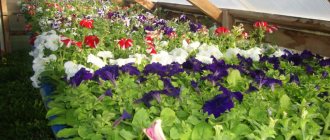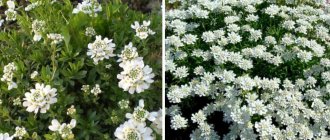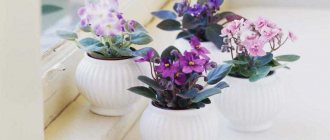Quote from message Galina5819
Read in full In your quotation book or community!
FAST, SIMPLE and CORRECTLY rooting cuttings of indoor plants
Most indoor plants can be propagated vegetatively - by cuttings, layering, children or dividing an adult plant. At first glance, everything is simple: cut off a cutting, stick it in the ground and wait for it to take root. In fact, such a trick is not always possible and not for everyone. This matter requires experience and skill.
For some people, everything they plant grows and prospers; in England they are called “green hands.” Most of us sometimes manage to root a cutting and grow a plant from it, but more often the planting material rots or dries out. What do you need to know about rooting cuttings in order to propagate your favorite indoor flowers without any problems?
WHAT SHOULD BE DONE
Before you begin harvesting cuttings and rooting them, it is important to decide on the following issues:
- Find out what kind of houseplant it is, whether it can be propagated by cuttings and read tips on how to do this specifically for this species;
- Select and cut the cuttings correctly;
- Prepare dishes for rooting and soil suitable for this plant;
- Treat with a root growth stimulator, if necessary;
- Plant the cuttings and care for them properly.
Some indoor plants take root easily and quickly. There are no problems with the rooting of balsam, zonal pelargonium, tradescantia, and coleus. Large-flowered pelargoniums are more capricious. Ficuses and begonias are almost always successfully propagated by cuttings. Azaleas and gardenias are difficult to root. If you don’t have any experience, then it’s better to practice on the most unpretentious and easily rooted house flowers.
Yeast solution
A very useful fertilizer for both indoor and flower bed flowers. It perfectly stimulates the development of the entire plant and its root system, making it stronger and more resilient. The method is also very effective for seedlings.
It’s easy to prepare this fertilizer - dilute 1 tablespoon of yeast and 45 g of sugar in a bucket of warm water, let the solution cool and brew for several hours. Experienced gardeners also add hops to this fertilizing, which will speed up the fermentation process and give the fertilizer more nitrogen reserves. Before use, it is better to dilute the solution slightly, as it is a concentrate and can burn plant roots.
- Author: iarriba
Rate this article:
- 5
- 4
- 3
- 2
- 1
(2 votes, average: 5 out of 5)
Share with your friends!
HOW TO CUT CUTTINGS CORRECTLY.
- For rooting, cuttings are taken from a healthy specimen. Indoor plants affected by pests and fungal diseases must first be cured.
- Cuttings are cut with a sharp knife, woody shoots are cut with pruning shears. Thin and tender stems cannot be cut with scissors, although this seems convenient - the cut site is compressed, the tissue is injured and the cutting then quickly rots.
- The cuttings are cut small, they should have 3-4 leaves. The length of the cutting itself can be different for different indoor plants; it depends on the distance between the leaves. In some species, apical cuttings root better; in most, apical and lateral cuttings take root equally.
- The bottom cut should be just below the knot. The stems of many indoor flowers easily break off at the internode; this is the best place for separation. It’s even better if the cutting has a “heel” - the place where this branch grew from the main trunk. When rooting in water, you can see that the roots of some plants (impatiens or zonal pelargonium, for example) appear along the entire length of the cutting, immersed in water. In others they grow only from the bottom cut. There are plants whose roots appear only from the node.
- The lower leaves are immediately removed; upon contact with wet soil or water, they rot, affecting the cutting itself.
- Some plants have a large leaf area, and planted cuttings evaporate a lot of water. The leaf blades are partially cut (by a third or half).
- If there are buds or flowers on the cutting, they must be removed, otherwise the cutting may simply not have enough strength to form roots.
- It is not recommended to immediately place freshly cut cuttings in water or soil. Most houseplants need to sit outdoors for a few hours before planting.
Green onions
- We take medium or large sized dense onions and immerse the bottom part in a container filled with water. But not completely, but so that only the roots are in the water.
- To make the formation of feathers more active, you can slightly cut off the top of the bulb.
- Onions can also be grown in soil, but this is a more complex process that requires constant soil moisture.
ROOTING IN WATER.
The easiest way to propagate houseplants is to cut a branch, put it in water and wait for the roots to appear. But not all plant species develop roots under such conditions. Many simply rot after a while. Saintpaulia, balsam, zonal pelargonium, tradescantia, ivy, and coleus are usually propagated in water.
What to root in? In any small glass or plastic container. In a glass, for example. It is noteworthy that roots appear faster in dark glass dishes. The cuttings are placed so that the lower part is submerged shallowly. Roots require the presence of oxygen to form; they form at the interface between water and air. The water level in the glass should be such that the ends of the cuttings are in the water, but most of them are above the water level.
What water should I use? Regular, from the tap. Some advise taking only boiled water, it does not contain microbes, but in fact they are introduced there as soon as the cutting is placed in it. It is impossible to disinfect a plant without destroying it. In addition, in the ordinary air of an apartment there are more than enough various microorganisms. Melt water is useful, it does not contain salts and is effective for rooting.
Do I need to change the water in the container with cuttings? No, you should not change the water under the cuttings, but only add it if necessary. They often die after changing the water. Probably, some kind of stable environment is formed in the glass from the waste products of the plant, promoting root growth. Saintpaulia leaves and passionflower cuttings that have already produced roots sometimes die after changing the water. Place an activated carbon tablet in the water to inhibit putrefactive processes.
How many cuttings can be placed in one glass? A little, 1 or 2. The more capricious the plant, the less. In a large mass, cuttings usually all die. As soon as one begins to rot, this process will affect everyone else.
How flowers can be sown in open ground, and they will bloom the same year
Every summer resident wants not to bother with seedlings, but to simply sow them in the ground and enjoy flowering in a few weeks.
Let's look at which flowers quickly sprout and bloom when sown in open ground.
Marigold
This is probably the most favorite flower among gardeners.
Yellow-orange flowers are used everywhere to decorate gardens, home areas, and also in city landscaping.
Marigolds are extremely unpretentious to growing conditions.
Show good germination.
Their advantage is that after flowering the seeds can be collected.
These seeds will be useful for sowing next year.
When and how to plant marigold seedlings
"Marigold"
Calendula (marigold) is the second most common flower in gardens and household plots in our country.
It sprouts well and relatively quickly from seeds.
Sowing in open ground is carried out already in April.
Flowering lasts from June throughout the summer.
Marigolds are also loved by summer residents because this flower drives away parasites with its scent.
Therefore, flowers can often be found in the aisles of vegetables.
Lavatera
“Wild Rose” blooms already in June and continues to delight with its inflorescences right up to the first frost.
Seeds are sown at the very end of May.
They sprout within a week after sowing.
Lavatera is good because it does not require special care and a certain type of soil.
Growing lavatera from seeds at home
ROOTING IN THE SOIL
Some plant species do not grow roots in water. They can stand in it for a month and not sprout a single root, while they will appear in the ground within a week. The general rule is this: plants from swamps and tropical rainforests take root easily in water; species from arid areas are best planted in the ground.
Petunias, large-flowered pelargoniums, fuchsias, begonias, hydrangeas, and hibiscus are rooted in the soil.
SOIL FOR ROOTING
What soil should I use to root cuttings? Loose, able to retain moisture well, with neutral acidity. For most crops, a simple mixture is most often used: peat in half with coarse sand. Or other inert soil that is not prone to rotting. You can add perlite and vermiculite and coconut fiber to peat. Sphagnum moss is useful, it has disinfectant properties and retains water well. Too loose soil dries out quickly.
Soil sterility. The soil for rooting cuttings of indoor plants should not contain fungal infections and insect pests. Many flower lovers steam garden soil, fry it or freeze it. The safest thing to do is buy ready-made soil at garden centers and add roasted sand to it. This purchased land is treated with fungicides and insecticides, which reliably protects the plants for some time.
Soil acidity. The acidity of the soil affects rooting. Usually they buy soil with neutral acidity from the store. Most types of indoor plants take root best in it. Hydrangeas need acidic soil; their cuttings root most effectively in slightly acidic soil. The general rule for most plants is this: the acidity of the soil for rooting should be close to that required for an adult plant of this species, but slightly closer to neutral.
ROOTING WHERE
Disposable plastic cups are good for rooting cuttings. If one cutting rots, the rot will not spread to other cuttings. Through the transparent walls you can see the emerging roots. Be sure to make a drainage hole in the bottom of the cup. It is advisable to place a little perlite or pieces of polystyrene at the bottom to allow excess water to drain freely.
The downside of the cups is their small volume. If you missed a glass when watering, the cutting may dry out.
Conventional seedling boxes or special pallets (cassettes, trays) with cells are convenient for rooting a large number of cuttings. In the boxes, moisture is distributed more evenly, the cuttings are arranged more compactly and are easier to care for.
For small cuttings, plastic food containers with a transparent lid are considered the most convenient option. They are quite rigid, the lid is easy to open when ventilated, and it is easy to make drainage holes in them.
When choosing dishes for rooting, follow these rules:
- If the plant does not tolerate transplantation well, take cups;
- If there are a lot of cuttings, their survival rate is low - choose boxes or pallets.
Cuttings of citrus fruits, myrtles, and oleanders are usually planted in boxes. The crowns of these plants need to be molded and pruned, after which many branches remain, quite suitable for cuttings. Not all of them will take root, but some of them will still take root.
HOW TO PLANT A CUTTING
The question seems simple. At first sight. Some plants have roots that grow along the entire length of the stem buried in the soil. The deeper you plant, the more roots there will be. In others, they appear only from a thickening at the cut site, and new shoots will grow from there. This place should not be very deep from the soil surface.
A universal method is to plant cuttings not strictly vertically, but obliquely, at approximately an angle of 45 degrees. Then the lower end of the cutting is not located deeply, and a fairly large part of the shoot is in contact with the soil.
Some plants (scindapsus, syngonium, monstera) have large distances between nodes; the length of the cutting can be 20-30 cm. They are unstable when planted in the ground. Tall plastic glasses or bottles with the top cut off are convenient for them. The soil is poured onto the bottom of the vessel, and the walls serve as support.
Some indoor vines are capable of growing aerial roots; they take root easily when in contact with the ground. Cuttings of Wood's Ceropegia and Philodendron can be rooted if you simply place them on moist soil, pressing them down with pebbles at the nodes, and spray them regularly.
Growing from seeds at home
You can grow flowers from seeds at home and later transplant them into open ground. Sowing should be done before the beginning of spring so that the flowers become stronger and bloom faster.
- In January, plants are sown, the flowering of which should occur 5 - 6 months after sowing. The longer it takes from planting the seeds to the start of flowering, the sooner you need to start sowing the seeds. During this period, Shabot carnations, clematis, irises, perennial violets, lavender, primrose, and begonia are sown.
- In February, you can start sowing petunias, lavender, fuchsia, balsams and pelargonium. It is necessary to take into account that full growth of these plants is ensured by long daylight hours, so they may require additional lighting in the form of fluorescent lamps.
- In early spring, seeds of echinacea, cloves, snapdragon, phlox and verbena are sown. In March, you can re-sow those plants that for some reason were not sown in February. Ageratum, alyssum and annual aster should be sown at the end of March.
- It is not too late to sow seeds in April. During this period, marigolds, amaranth, daisies, calendula, fragrant mignonette and delphinium are sown as seedlings.
You can buy flower seeds at any flower shop that offers a wide range of planting material. Qualified sellers will give advice and help you decide on the choice of flowers suitable for a specific area, planting site and soil. The boxes and bags of seeds indicate a description of the variety, planting and flowering dates. When purchasing seed, you need to pay attention to the expiration date. An expired seed may not sprout.
Collection and storage of seeds
You need to start collecting flower seeds at the end of the season. Self-collected seed material helps you save on purchases and gives you confidence in the quality of the seed.
Hybrid varieties are not suitable for seed propagation because they do not inherit parental characteristics. As a result of sowing seeds of hybrids, you can get plants with completely different characteristics or not get seedlings at all. It is better to propagate such flowers by cuttings or purchase seeds in the store, especially when it comes to annuals.
In order for the seeds to germinate well, they must be collected on time. After ripening, the seed material of many plants crumbles to the ground, and it will be impossible to collect it. In addition, a self-dispersed seed may sprout next season in a place not intended for this variety.
- Plants whose seeds are collected in capsules, such as marigolds or asters, need to collect seed in dry, sunny weather. High humidity or getting the bolls wet can cause them to rot and spoil the seeds.
- It is recommended to collect the seeds of annual phlox, alyssium, balsam and garden geranium early in the morning during dew or in wet weather so that the boxes and pods do not crack. You can collect seeds that are not yet ripe, but in this case there is a risk of poor seedlings.
- For plants whose seeds are collected in ears, collection is carried out using a paper bag. The upper part of the spikelet, where the seeds have not yet ripened, should be cut off with scissors, and the remaining part of the inflorescence should be covered with a bag and the peduncle should be cut off. The bag must be turned over and shaken well so that the seed material falls to the bottom. In this way, the seeds of bells, delphinium and lupine are collected.
After collecting inflorescences or unripe seeds, they must be thoroughly dried. Inflorescences and boxes are laid out on dry sheets of paper or saucers. To ensure even drying, it is recommended to mix the seed material. In order to allow the seeds to ripen, they must be stored at a temperature of +20... + 24 degrees. The optimal temperature for drying is +30…+35 degrees. The seed should be kept away from direct sunlight, in a room with good ventilation.
Seeds should be stored in paper bags or fabric bags at a temperature of +15...+20 degrees, always in a dry place away from direct sunlight. On each bag you need to write the name of the flowers and the year when the seed was collected. A large number of seeds can be placed in boxes covered with paper. Proper storage will ensure good germination of plants next season both in the garden and at home when sowing seeds for seedlings.
Selecting a landing container
Before sowing seeds for seedlings, you need to select a planting container. For these purposes, you can use large boxes or individual containers and pots.
Sowing seeds in pots protects the seedling from injury during transplantation and reduces the risk of developing putrefactive processes. Separately planted seeds do not need picking.
Here are some recommendations from experienced gardeners.
- You should not use cardboard boxes for sowing. During watering, they get wet and break, which is why the plantings can become unusable. Also, in the production of cardboard, chemicals harmful to plants are used, which negatively affect the growth of seedlings and can lead to the death of seedlings.
- You can sow flower seedlings in plastic containers, including disposable cups. To do this, you need to make drainage holes in them, through which excess moisture will drain out when watering. You can use small flower pots that already have holes for draining water.
- Experienced gardeners recommend sowing flower seedlings in peat pots. Plants can be planted directly into open ground without damaging the root system of the seedlings during transplantation. The porous walls of the pots ensure normal air circulation and moisture passage to the roots. Such containers provide protection against bacteria and infections, since they are made from material that has been disinfected and does not contain toxic substances. Peat pots remain durable both dry and wet.
- Small flowers can be sown in peat tablets, which, when swollen, form a kind of cup. The peat substrate is filled with substances necessary for plant growth, provides good germination and protection from pathogens.
ROOT FORMATION STIMULANTS
Some gardeners, before planting cuttings, soak them in a solution of heteroauxin or other root formation stimulant. Such substances promote plant regeneration, stimulate root formation in cuttings, accelerate root formation in seedlings and adult plants, and enhance the growth of adventitious roots. There are different medications. The cuttings are either soaked in a solution, or sprinkled with powder, or watered under the root strictly according to the instructions.
These root formation stimulators make it possible to obtain new specimens from cuttings of even the most difficult plants to propagate.
CARE OF CUTTINGS
90% of rooting success depends on proper care of planted cuttings of indoor plants. Caring for cuttings largely depends on the type of plant, but there are rules that are common to all.
MOISTURE CONSERVATION AND WATERING
Do you need film? It is almost always recommended to cover rooting shoots with film or glass to protect them from drying out, leaving a small hole for ventilation. For cuttings planted in cups, just put a small plastic bag on top.
This requirement is not relevant for all plants, but it won’t hurt, especially in the first days. Succulent plants, as a rule, are not covered with anything.
Important! Be sure to ventilate regularly! How often? If it’s cool, it’s enough to open it once a day for half an hour; if it’s hot and there are a lot of water droplets on the film, open it 3 times for 10-15 minutes. From excess condensation, cuttings easily rot. Frequent spraying accelerates rooting, but plants with pubescent leaves or shoots are not recommended to be sprayed.
When the first roots appear, the film can be removed. Spraying continues.
Should I trim the leaves? Cuttings of plants with large leaves evaporate a lot of moisture, and the soil dries out quickly. It is useful to cut the leaf blades of cuttings by half or 2/3. This is done with cuttings of lemons, indoor roses, hibiscus, and gardenias. Fleshy thick leaves are not shortened. They already hold moisture well, but when damaged they begin to rot.
How to water? Cuttings covered with film are watered infrequently; make sure that the soil is slightly moist. It is better to water with soft, settled water at room temperature or a few degrees warmer. When roots appear, the plant begins to absorb more moisture from the soil and evaporate more of it, watering is increased, and the cover is removed.
TEMPERATURE REGIME
Temperature is the most important factor for most plants. Chopped shoots actively develop in warm conditions. The optimal temperature is 22-28°C. Moreover, not only the air should be warm, but also the soil. In winter, even the most unpretentious plants cannot take root on cold windowsills.
Plants of the tropics require higher temperatures; many representatives of subtropics and temperate climates form roots at 20 degrees. Very heat-loving exotic species take root only with bottom heating! To do this, you can place the container with cuttings on a warm windowsill above the radiator or buy a special heated box for seedlings.
When it's very hot, that's also bad! At temperatures above 30 degrees, most cuttings die.
As soon as you notice the appearance of roots (transparent containers are very convenient in this regard) or the beginning of the growth of a new leaf, it is advisable to lower the temperature to normal room temperature.
Most websites dedicated to houseplants advise rooting cuttings in spring or late summer. These tips are correct for most species. And often the point here is not that the roots do not grow at other times. They are growing! But during these periods it is easiest to ensure the required temperature and light conditions without any special tricks.
LIGHTING
Sunlight stimulates growth. It would be a mistake to place the cuttings in the shade, where the sun practically does not penetrate. There should be a lot of light, but it should be diffused. In the summer heat, it is better not to keep them in the midday sun to prevent overheating. But the morning and pre-sunset rays will be beneficial, especially for cuttings of sun-loving species (hibiscus, gloxinia, pelargonium).
Some types of plants are rooted by cuttings without leaves (grapes, barberries); they can also be kept in a shaded place. The reason for this is that if the cutting was harvested in the fall, at a time when the plant no longer had leaves, then it contains a certain amount of heteroauxin, which stimulates the formation of roots.
Seed placement depth
If the planting is too deep, the sprouts will not be able to break through to the surface. Small sowing will cause the seedlings to dry out and die.
The planting depth depends on the size of the seed:
- very large (sunflower, legumes, pumpkin, watermelon) - 4-5 cm;
- large ones (beets, cucumbers) – 3 cm;
- medium (cabbage, onion, tomato, pepper, eggplant) - by 2 cm;
- small (celery, lettuce) - 0.5-1 cm.
Strawberries and petunias have very small, dusty seeds. They are not buried, but simply scattered over the surface, sprayed with a spray bottle and covered with a transparent film to prevent the soil from drying out.
TRANSPLANTING YOUNG PLANTS
The resulting seedlings need to be transplanted into separate pots. For many plants, this stage is considered the most difficult. Many species do not tolerate root damage. Others don't like changes in temperature or soil.
How to replant? The rule is simple - replant rooted cuttings only by handling, without shaking off the soil, trying not to damage the weak roots.
When to replant? The shoots rooted in the cups are replanted when it is clear that the roots have entwined the earth well. If the walls are not transparent, then replant if roots appear in the drainage hole. Cuttings in a common box are more difficult to separate from each other; they are usually replanted when they begin to grow and produce a new leaf. Being late in replanting from a separate cell or cup will not do much harm; it will only slow down the development of the plant a little, while in a box the roots may become so intertwined that it will be difficult to separate them.
How to adapt? A sudden change in conditions can destroy the plants obtained with such difficulty. If the seedling is moved to another place or into the open air, then before transplanting it must be accustomed to the new habitat. The shelter is removed from it, moved to another place, first for several hours, then the time is increased. Plants must get used to lower temperatures and different lighting.
UNUSUAL METHODS OF CUTTINGS
There are quite exotic, but effective, rooting methods. Often they allow you to root even plants that are difficult to take cuttings.
For example, in potatoes. To do this, the tuber is thoroughly washed, all its eyes are removed, and the desired cutting is inserted into the hole made. Then the tuber is buried in the ground, and the cutting is covered with a glass jar or film and watered regularly. At the same time, the cuttings are supplied with a large amount of nutrients and actively produce roots, and the plants subsequently grow and develop well. Even capricious roses can be rooted this way!
Or, another way: a twig is stuck into a piece of a special floral sponge to extend the life of cut flowers. It retains moisture for a long time and is treated with special antibacterial substances. For example, this sponge is good for rooting fuchsia.
The burrito method has worked well for roses. In this way, you can root cuttings no less thick than a pencil. Take cuttings with 3-4 buds and remove all leaves. They are treated with a root growth stimulator and several pieces are wrapped in wet newspaper. The cuttings packed in paper are placed in a dark plastic bag and left for 3 weeks at a temperature of 14-18 degrees. A basement works well. After the specified time, they are taken out and the newspapers are carefully removed. If roots appear on the branches, they are planted one at a time in pots so that the top bud rises above the surface. The pot is covered with film to reduce evaporation. The temperature should now be above 23-25 degrees.
Fertilizing seedlings
Without fertilizers you cannot get good seedlings. In the first few weeks, the plants will have enough nutrients stored in the seed. But when 2-4 permanent leaves develop, the seedlings can begin to be fed.
Fertilizer for seedlings must include:
- nitrogen,
- potassium,
- phosphorus,
- microelements.
Liquid organo-mineral complexes are convenient. They are completely balanced and easy to apply during watering. Infusions of bird droppings, herbs or mullein cannot be used at home. This is unhygienic; in addition, if the dosage is not observed at the slightest level, the caustic liquids will burn the roots and leaves.











